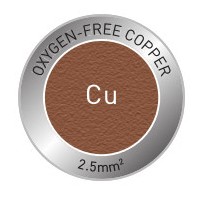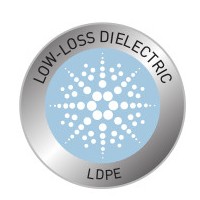QED XT25 Speaker Cable
Key Features
- A price-to-performance workhorse
- Low-loss dielectric (LDPE) shields the cable and creates a more pleasing musical experience
- 99.999% Oxygen Free Copper ensures high quality conductors with good signal retention
- X-Tube Technology adds central hollow insulating rod that optimises signal-contact
- Cost-effective technology that simply improves sonic performance and listening experience
The QED Performance XT25 Speaker Cable, the price-to-performance workhorse that elevates your audio experience to a whole new level. While the technology used within this cable may not be the most glamorous or sophisticated, it is praised for being highly effective and low-cost. This means you can enjoy many of the sonic benefits typically associated with more expensive cables, without having to break the bank. With 99.999% Oxygen Free Copper conductors, this cable ensures high-quality signal retention, minimizing signal loss and preserving audio fidelity. The QED Performance XT25 Speaker Cable incorporates X-Tube Technology, which adds a central hollow insulating rod. This innovative design optimizes signal-contact and distribution, further improving the cable's performance and enhancing your listening experience.
Product Ref: 205523
Full Description
"We know QED for sensational levels of clarity and detail, and, even at this lower price, it doesn’t disappoint. This kind of transparency is difficult for rivals to match."
X-Tube technology first came to prominence in 2005 with the launch of the world renowned Silver Anniversary XT, the most highly awarded mid-range cable in the world, winning the What Hi-Fi Product of the Year three years in a row. These design principles also grace the multiple award winning XT40 speaker cable and XT25.
As frequency increases, electrons flow more and more towards the periphery of a conductor so that if the frequency is high enough only a very thin layer (or skin) on the outside of the conductor is used. This “skin depth” varies for different materials at a fixed frequency and in copper it means that if a conductor has larger than 0.66 mm2 cross-sectional area not all of that area is available for an analogue music signal to use.
In SAXT the “skin effect” problem was effectively eliminated by the use of X-Tube™ Technology which works by placing all of the conducting material around a central hollow insulating rod. However, for a.c. signals, changing magnetic fields generated by the flow of current set up eddy currents in nearby conductors which force current to flow only in areas furthest away from conductors carrying current in the same direction and vice versa.
How to Order
To order bare speaker cables, select the length you require and 'Add to Basket', price is per metre of cable. Please note: All speaker cables are supplied in one continuous length unless ordering with terminations. To add termination options please use the tool above. Select your required 'Amplifier Termination' & 'Speaker Termination' plugs, then select your required length and quantity. Finally 'Add to Basket' and the total price will be calculated.

X-Tube Technology
In loudspeaker cables high pitched sounds are forced to travel towards the outside of the conductor and so are able to use less and less of the available cross-sectional area as the pitch increases. This is called the “Skin Effect”. It means that for high frequencies the resistance of the cable appears to be much higher than it does for lower pitched sounds. Eddy currents in one conductor can affect the current flowing in an adjacent conductor so that currents flowing in the same direction move away from each other. This “Proximity Effect” also increases resistance as frequency increases. These phenomena have a detrimental effect on the fidelity of the sound you hear. The XT25 variation of QED X-Tube Technology solves these problems by creating a hollow tubular conductor geometry out of individual conductor bunches through which each frequency can pass with equal ease when compared to traditional solid or stranded conductors.

99.999% OFC
Speaker cables need to have a large current carrying capacity. If the electrical resistance of the cable is too large, part of the music signal will be lost, causing a detrimental effect on the fidelity of the sound you hear. To stop this from happening we make the resistance of our speaker cables as small as possible. QED do this by using the largest practical cross-sectional area of copper within the size constraints of each cable. In order to squeeze the last drop of performance from the conductors QED make sure that there are no impurities in the copper which would defeat the object of making them so large. That’s why QED use 99.999% oxygen-free copper exclusively.

Low-Loss Dielectric
Music signals in a loudspeaker cable move back and forth many times every second. The insulating material used to separate the send and return conductors from each other (the dielectric) has to be charged and discharged every time. Not all of the energy stored in the dielectric during each charge cycle is completely returned during each discharge cycle which has a detrimental effect on the fidelity of the sound you hear. That’s why at QED they use low-loss dielectric materials such as Polyethylene (PE) or Teflon (PTFE) in preference to cheaper PVC alternatives found in inferior unbranded cables.

| Cross-sectional area | 2.5 mm2 |
|---|---|
| Wire gauge | 14 AWG |
| Jacket outside diameter | 3.96 mm |
| Loop inductance | 0.52 μH/m |
| Loop resistance | 13.4 mΩ/m |
| Capacitance | 35.0 pF/m |
| Dissipation factor @ 10 kHz | 0.0001 |
| Conductors | 10 x 19/0.13 mm |
| Insulation | LDPE jacket with 100% coverage of Aluminium Mylar tape wrap |
| Reviews of our service
View all













